Upcoming Washin Kai Events
2025 Washin Kai Autumn Lecture
Binging Shogun: Can Historical Fiction Be Good for History?
Prof. David Spafford, Department of East Asian Languages and Civilizations, University of Pennsylvania
Monday, December 8, 2025, 6:00pm
Town Hall Seattle
1119 Eighth Avenue
Seattle, WA 98101
When Shogun was released last year on Hulu, it featured a great cast, spectacular visuals, and a gripping story. It was a commercial and critical success on release, and again when awards season came around. So of course, academic historians fretted. Were they concerned that it painted sixteenth-century Japan as another Game of Thrones (with more ninjas and fewer dragons)? Maybe a little. But most scholars were anxious because they understood how important the show would be, how profound an impact it would have, for years to come, on the public’s perception of Japanese culture and history — all the more so because the story captures a moment of extraordinary significance, in such vivid detail, on such a vast canvas.
In this talk, David Spafford, Associate Professor of Premodern Japanese History at the University of Pennsylvania, takes a closer look at the complexities of the period and unpacks why this particular moment in history matters so much — and how the hit Shogun series does (or doesn’t) help us understand it.
David Spafford was born and raised in Rome and first moved to the States to earn his PhD. He is currently Associate Professor of Premodern Japanese History in the Department of East Asian Languages and Civilizations at the University of Pennsylvania, where he teaches courses on samurai and the invention of the Way of the Warrior, on early modern urbanization, and on premodern law and violence. He is the author of A Sense of Place: The Political Landscape in Late Medieval Japan (2013), which explores the resilience of medieval regional identities and cultural geographies during the early Warring States period. In recent years, he has written about the role and boundaries of kinship in warrior society between 1450 and 1650. He is currently completing a short monograph on the writings of a sixteenth-century widow, known to us only as Jukeini, the only woman to rule a warrior domain.
Register online through Town Hall Seattle. Presented by Town Hall Seattle and Washin Kai. This event is sponsored by the University of Washington Center for Japanese Studies and the Department of Asian Languages and Literature.
2026 Washin Kai Spring Lecture
Speaker: Prof. Ted Mack, Department of Asian Languages & Literature, University of Washington
Tuesday, April 7, 2026, 5:30-7:00pm
Kane Hall 210
Stay tuned for additional details!
Past Washin Kai Events
2025 Washin Kai Spring Lecture
Ryukyuan Landscapes and Identity in the Omoro Sōshi (1531-1623)
Speaker: Prof. Davinder Bhowmik, Department of Asian Languages & Literature, University of Washington
Tuesday, April 8, 2025, 5:30-7:00pm
Kane Hall 210
The Omoro Sōshi is an indigenous compilation of 1500 songs, poems, and prayers that extoll the golden age of the Ryukyu Islands. It offers insights absent from official histories that focus on great heroes. The collection sheds light on the Ryukyu's semitropical flora and fauna, and by extension, the everyday life of the common people.
This presentation will introduce the main features of the Omoro Sōshi and pay particular attention to key aspects of the landscape that shaped traditional communal formations. Its aim is to consider whether the compilation reflects a history of the region as top down (Yamato) or bottom up (Ryukyu).
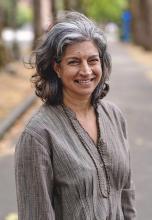
Davinder Bhowmik is Associate Professor of Japanese in the Department of Asian Languages & Literature at the University of Washington. She teaches on and researches modern Japanese literature, with a specialization in prose fiction from Okinawa, where she was born and lived until the age of 18. Other scholarly interests include regional fiction, the atomic bombings, and Japanese film. Her publications include Islands of Protest: Japanese Literature from Okinawa (co-edited with Steve Rabson, 2016); Writing Okinawa: Narratives of Identity and Resistance (2008); and “Temporal Discontinuity in the Atomic Bomb Fiction of Hayashi Kyōko" (in Ōe and Beyond: Fiction in Contemporary Japan, 1999). She is currently writing a manuscript on military basetown fiction in Japan.
This was an in-person event that was livestreamed and recorded via Zoom. View the recording of the lecture on the Department of Asian Languages & Literature's YouTube channel.
Read Prof. Bhowmik's article in the Northwest Asian Weekly, "The Enduring Power of the Omoro Sōshi".
Sponsored by Washin Kai - Friends of Classical Japanese with support from the Department of Asian Languages & Literature and the Language Learning Center at UW. Nominal support by the Consulate-General of Japan in Seattle.
The Popularization of the Hundred Poets in Edo-Period Japan
Speaker: Prof. Joshua Mostow, Department of Asian Studies, University of British Columbia
October 23, 2024, 6:00 – 7:30 pm
Kane Hall 210
Join us on a journey exploring how knowledge of the Hyakunin isshu (One Hundred Poets, One Poem Each) collection spread among the commoner class in Japan’s early modern Edo period (1600-1868) to become the foundation of popular literary literacy through the booming print culture, especially by means of illustrated commentaries in books and popular prints. A distinctly vernacular interpretative tradition will be revealed, one that heavily influenced the earliest English translations of these poems.

Joshua Mostow is Professor in the Department of Asian Studies at the University of British Columbia, Vancouver, Canada. He has written widely on premodern Japanese literature and its relations to visual arts. His most recent publication is Hyakunin’shu: Reading the Hundred Poets in Late Edo Japan (University of Hawai‘i Press, 2024).
Sponsored by the UW Japan Studies Program and Washin Kai - Friends of Classical Japanese with support from the Department of Asian Languages & Literature and the Language Learning Center at UW. Nominal support by the Consulate-General of Japan in Seattle.
Chinese Characters across Asia: Continuity and Transformation in Japanese, Korean, and Vietnamese
Speaker: Prof. Zev Handel, Department of Asian Languages and Literature, University of Washington
April 3, 2024, 7:00 – 8:30 pm
Kane Hall
Chinese characters originated in China over 3,000 years ago. Prior to their creation, East Asia was completely devoid of writing. By the time of the Han Dynasty (202 BCE – 220 CE), China already had a long literary tradition, a flourishing culture, and a sophisticated government bureaucracy. Chinese writing exerted an enormous influence on surrounding peoples and places, including the areas of modern-day Korea, Japan, and Vietnam. Eventually, the Chinese-character script was adapted to write the languages spoken in these three places. At one time, the spoken languages of Korea, Japan, and Vietnam were all written entirely in Chinese characters — yet these languages are as different from Chinese as is spoken English. In this talk, Zev Handel explains how the building blocks of the Chinese script were adapted to represent the words and sounds of Japanese via their transformation into the scripts known as kanji and kana. This transformation made possible the rich and varied literary inheritance of Japanese, from the poetry of Man’yōshū to the modern science fiction novel. Along the way, you’ll learn in what ways Chinese writing is similar to and different from alphabetic writing, what happened to Chinese-character writing in Korea and Vietnam, and why today Japanese is the only one of these languages that still uses Chinese characters in its writing.
All are welcome to attend. No prior knowledge of any of the languages or of Chinese characters is expected or presumed.
This was an in-person event that was livestreamed and recorded via Zoom. View the recording of the lecture on the Department of Asian Languages & Literature's YouTube channel.
Read Prof. Handel's interview in the Northwest Asian Weekly in which he discusses some of the themes and topics explored during the talk, as well as in his forthcoming book, Chinese Characters across Asia: How the Chinese Script Came to Write Japanese, Korean, and Vietnamese (UW Press, 2024). Read a write-up of the lecture in The North American Post.
Washin Kai Conversation: Kukai’s Gravitational Force in Japan’s History
Speaker: Ven. Taijo Imanaka, Seattle Koyasan Temple
January 25, 2024, 3 – 4:30 pm
Communications Building, CMU 120
Mt. Koya, a UNESCO World Heritage site, is one of the two most sacred Buddhist sites in Japan. Since the ninth century, Mt. Koya has attracted countless historical figures including emperors, the nobility, and samurai. Among them were many mutual enemies such as Taira vs Minamoto clans, Oda Nobunaga vs Akechi Mitsuhide, and Tokugawa vs Toyotomi clans. Everybody wanted to be close to Kukai, the monk who established the temple complex on Mt. Koya over 1,200 years ago. Ven. Taijo Imanaka, will discuss the history of Mt. Koya and its significance in Japanese literature.
About the speaker: Ven. Taijo Imanaka
In 1992, Ven. Taijo was ordained at Rengejoin, a Koyasan Shingon monastery on Mt. Koya in Japan, as a disciple of Dharma Master Ryusho Soeda. In 2006, he was assigned as Head Priest of Seattle Koyasan Buddhist Temple, which is in Seattle Downtown. In 2011, he was assigned as the chef monk at Entsuritsuji, one of the oldest training monasteries on Mt. Koya and cooked shojin ryori (vegetarian Buddhist cuisine) every day for hungry novice monks. Since 2020, his temple in Seattle has been conducting a Mandala Symphony meditation dedicated to the Black Lives Matter movement. Since the beginning of Russian Invasion to Ukraine, Ven. Taijo has started supporting a Buddhist community in Ukraine. In 2022, he started building a strong relationship with Ambedkarite Buddhist leaders in India. At Seattle Koyasan, Ven. Taijo often hosts field trips from Seattle University, University of Washington, and local elementary schools.
Washin Kai Presents "Washin Kai Conversations"
Manga, Light Novels, and Renga: A Talk with Three Translators
Wednesday, May 24, 2023, 11 a.m. – 12:30 p.m.
CMU 202
Washin Kai is hosting a small "conversation"-style talk featuring three Asian Languages and Literature graduate students and alumni who will discuss their experiences translating different mediums from Japanese into English: Anna (manga), Amanda (light novels), and Juan Felipe (renga poems).
Speaker bios:
- Anna Schnell is a UW graduate student studying Japanese literature. She translates manga (comics) from Japanese to English for the small independent publisher Glacier Bay Books.
-
Amanda Schiano di Cola graduated from UW with an MA in Japanese Linguistics in 2021. She is a freelance Japanese to English translator currently working on a light novel series for the digital publisher J-Novel Club.
- Juan Felipe Arroyave is a first year graduate student in the Japanese Literature program at UW, but he previously received a PhD in Hispanic Studies in 2019. He translated the Ogura Hyakunin Isshu into Spanish in 2021, and is currently working on a translation of Bashō's Sumidawara, his last renga collection.
“Visions of the Katsura Imperial Villa”
Wednesday, April 19th, 2023
7:00 - 8:30 PM
Location: Gowen Hall 301
(*Event was also live-streamed via Zoom.)
The architecture and gardens of the Katsura Imperial Villa 桂離宮 live on today as a paradigm of Japanese arts and cultures. Commissioned by two generations of princes of the Hachijō Imperial Family in the seventeenth century, this Xanadu embodies the ideals of tea master and artist Kobori Enshū 小堀遠州 and stands as an emblematic expression of both sukiya-zukuri architecture and modern design. This talk by Professor Ken Tadashi Oshima and conversation with Professor Paul Atkins and architect Hiroshi Matsubara will unpack the many facets of Katsura including its literary and photographic interpretations to consider its implications for the future of Japanese traditions in a global context.
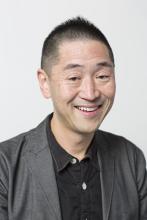
Ken Tadashi Oshima is Professor in the Department of Architecture at the University of Washington, where he teaches in the areas of trans-national architectural history, theory, representation, and design. He has also been a visiting professor at the Harvard Graduate School of Design and taught at Columbia University and the University of British Columbia. He earned an A.B. degree, magna cum laude, in East Asian Studies and Visual & Environmental Studies from Harvard College, M. Arch. degree from U. C. Berkeley and Ph.D. in architectural history and theory from Columbia University. From 2003-5, he was a Robert and Lisa Sainsbury Fellow at the Sainsbury Institute for the Study of Japanese Arts and Cultures in London.
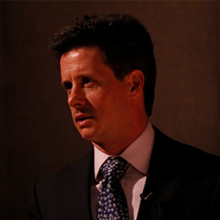
Paul S. Atkins is Professor of Japanese in the Department of Asian Languages and Literature at the University of Washington, Seattle, where he teaches and writes about the literature, drama, and culture of medieval Japan. He holds a Ph.D. in Japanese from Stanford University. He was awarded the William F. Sibley Memorial Translation Prize by the University of Chicago in 2011 and the Kyoko Selden Memorial Translation Prize by Cornell University in 2021 for his translations of classical Japanese texts into English.
Please note: Videorecording of this lecture will be made available upon request. To protect the copyright, the recording is offered only for the requester's personal viewing. Please email asianll@uw.edu to request the link to the recording.
"What is Haiku?" with Professor Paul Atkins
Wednesday, October 19, 2022
Recording (Version 1): PowerPoint View
Recording (Version 2): Audience View
What is Haiku?
It is well known that haiku are very brief Japanese poems, probably the shortest poems in the world. With their simple syllabic pattern and lack of rhyming, they are easy to write—even children can and do write beautiful haiku! Although they originated in Japan, many millions of haiku have been written in various languages in addition to Japanese. Today, haiku truly belong to the world. How and why did haiku come about? Why are haiku so short? Why do they include precisely 17 syllables in a 5-7-5 arrangement? This talk, which presumes no knowledge of Japan or the Japanese language, will answer these questions and more. In an engaging overview of this fascinating topic, Professor Paul Atkins will discuss the origins of haiku in medieval Japan, introduce the major classic poets, and explore the ways in which haiku is linked to other forms of Japanese literature and art. Haiku is not just a poetic genre—it is a way of looking at the world and, for many people, a way of life. This talk will be followed by a moderated roundtable discussion between Professor Paul Atkins, and haiku poets Scott Oki and Mitsuko Miller.

Paul Atkins (Speaker)
Paul S. Atkins is professor of Japanese in the Department of Asian Languages and Literature at the
University of Washington, Seattle, where he teaches and writes about the literature, drama, and
culture of medieval Japan. He holds a Ph.D. in Japanese from Stanford University. Professor Atkins
was awarded the William F. Sibley Memorial Translation Prize by the University of Chicago in 2011
and the Kyoko Selden Memorial Translation Prize by Cornell University in 2021 for his translations
of classical Japanese texts into English.

Scott Oki (Roundtable Participant)
Scott Oki is the Founder and Chairman of o-kaisha Investment, LLC. and is a serial entrepreneur,
venture capitalist, philanthropist, author, and community activist. Scott worked for Microsoft for ten
years during the early days of the company. Upon his retirement from Microsoft, Scott immersed
himself in the philanthropic volunteer world. Over the next 30 years, he served on over 100 non-profit
boards and founded or co-founded 20. Scott is also a past-President of the University of Washington
Board of Regents. Now, much of his time is spent writing. Inspired by the seventeenth-century poet
Basho, Scott has written 2,525 haiku and published six volumes of haiku poetry, with four more to
come. He has also published a book of free verse, and the second one is expected later this year.

Mitsuko Miller (Roundtable Participant)
Mitsuko Miller has worked as a mortgage banker for 29 years while raising 3 sons. 10 years ago,
she joined Rainier Ginsha, a haiku association originally established in Seattle in 1932. During
WWII, Rainier Ginsha’s original selector, Banjin Koike, started Minidoka Ginsha at the Minidoka Concentration Camp. Banjin revived Rainier Ginsha in Seattle after the war. North American Post has
been publishing haiku by Rainier Ginsha for many decades. Through her association with Rainier
Ginsha, Mitsuko has not only discovered joy of composing haiku but also learned much about the
experiences of Japanese Americans during WWII in the Pacific Northwest, which has given her a
much deeper understanding of human life.
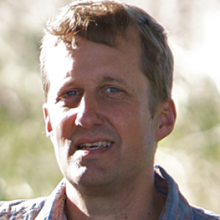
Bruce Rutledge (Moderator)
Bruce Rutledge founded Chin Music Press, an independent book publisher, in 2005. Since then, the
press has published award-winning books about Japan and the experiences of Japanese Americans
such as Are You an Echo?, Kaibyo: The Supernatural Cats of Japan, Shiro, We Hereby Refuse, Yokohama
Yankee, and Yurei: The Japanese Ghost. The press also publishes Origami Magazine. Bruce
lived in Japan for 17 years. He was on the Monbusho English Fellows Program from 1985 to 1987,
then worked for a series of news organizations including Universal News Japan, Nihon Keizai
Shimbun, NHK, and J@pan Inc. magazine.
The World of Noh Drama with Takeda Munenori
October 13, 2021
Recording: https://youtu.be/WuqFr4Og6z4
Takeda Munenori, the world-renowned Noh performer, and his ensemble of actors and musicians will present a number of Noh performances from Tokyo, with commentary by Professor Paul Atkins. This event will also feature a demonstration of tools and materials used in Noh drama and will be followed by a live Q&A with Master Takeda Munenori from Tokyo, and Professor Atkins, moderated by Professor Stephen Sumida.
Takeda Munenori was born in 1978 into the Takeda family that has been in the Nohgaku profession since the Edo period. He is widely regarded as one of the most engaging and charismatic performers of his generation. Takeda has recently conducted a series of workshops on Noh at the University of Edinburgh in Scotland and has travelled extensively to promote Noh to an international audience.
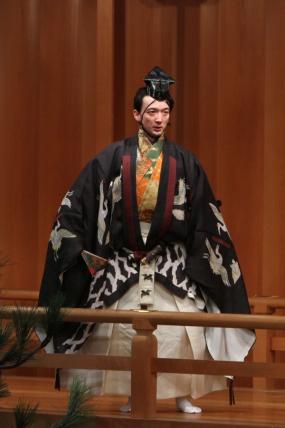
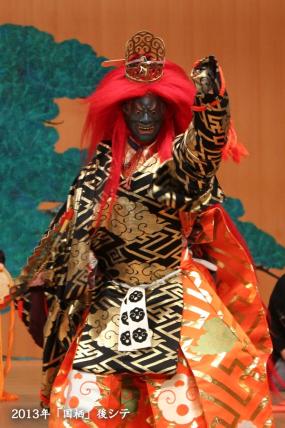
"What is Noh?" A Lecture by Professor Paul Atkins
September 22, 2021
Recording: https://youtu.be/6VPYXO6hlG0
Noh plays have been performed continuously in Japan for the past six hundred years. Noh is the oldest extant dramatic tradition in the world. Like opera, noh began as popular entertainment, originating in simple plays performed all over Japan at shrines, temples, and other venues.
In the fourteenth century, noh was elevated to high art through the efforts of the great actor, playwright, and theoretician Zeami (1363-1443) and others and the patronage of elite figures like the shogun Ashikaga Yoshimitsu (1358-1408). Part ritual, part entertainment, noh was granted privileged status by the Tokugawa shogunate and was closely associated with warrior culture. In the twentieth century, noh came to the attention of theater lovers in the West and inspired modern poets and playwrights. Today, noh is offered as an exemplar of traditional Japanese culture, a masked dance-drama that combines poetry, instrumental and vocal music, dance, costume, architecture, and sculpture with great subtlety and unparalleled artistry.
This talk by Paul Atkins, professor of classical Japanese at the University of Washington, will provide an introduction to this fascinating dramatic form: its performance traditions, themes, history, and philosophy. It is designed for those with no previous familiarity with noh or the Japanese language. We hope that those who watch it will derive even more satisfaction from our upcoming performance and talk by the acclaimed noh actor Takeda Munenori, “The World of Noh Drama,” on October 13, 2021.
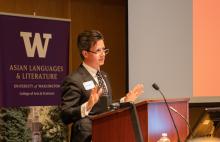
Hyakunin Isshu and the world of Japanese medieval poetry by Paul Atkins
March 3, 2021
Hyakunin isshu (One Hundred Poems by One Hundred Poets) is the most famous collection of poetry in Japan. It has been read, discussed, recited, memorized, copied, illustrated, and parodied for centuries and has been the subject of more than one series of manga and anime. Most people encounter it for the first time through a game in which players listen as a reader recites verses in random order and compete to be the first to snatch the card bearing the text of the corresponding poem. Widely believed to have been compiled by the poet and courtier Fujiwara no Teika (1162-1241), Hyakunin isshu has educated and delighted many generations of readers as a model of poetic composition and an introduction to the fascinating world of waka, classical Japanese poetry.
In this talk, Paul Atkins will provide an introduction to the content, structure, and history of this very influential anthology, with special attention to its mysterious origins in medieval Japan. When did it first appear? How was it created? What was its original purpose? You will be surprised (perhaps even shocked!) by the answers he proposes.
Paul Atkins is professor of Japanese in the Department of Asian Languages and Literature at the University of Washington. He teaches and writes about the classical language, literature, and culture of Japan with a particular emphasis on the medieval era (ca. 1150-1600). Author of Revealed Identity: The Noh Plays of Komparu Zenchiku
and Teika: The Life and Works of a Japanese Poet, and an award-winning translator, he holds a BA in English and an MA and PhD in Japanese from Stanford University.

Illustration of salt-making by the sea for Hyakunin isshu no. 97 (“konu hito wo,” by Teika). From the series One Hundred Poems Explained by the Nurse (Hyakunin isshu uba ga etoki), by Hokusai (1760-1849). Woodblock color print, collection of the Metropolitan Museum of Art.
Town Hall Seattle and Washin Kai Present Rakugo by Katsura Sunshine
Tuesday, October 20, 2020
Washin Kai and Town Hall Seattle welcomed renowned entertainer Katsura Sunshine for a special performance of unique storytelling called rakugo (落語). Rakugo is a 400-year-old tradition of comic storytelling in Japan. Katsura Sunshine starred in the NHK World TV series “Dive into Ukiyo-e”, emceed the opening reception for the G20 Summit in Osaka in 2019, and has performed in an extended run of shows Off-Broadway. This special English-language performance will be broadcast to us live from Tokyo.
Katsura Sunshine (桂三輝) was born in Toronto, Canada and began in entertainment as a playwright, composer and producer of musical theatre. In 2008 he became the 15th apprentice to the great Rakugo Master Katsura Bunshi VI (桂文枝), from whom he received the name Katsura Sunshine.
"Zen Master Zekkai: The Life of a Medieval Japanese Monk"
A Lecture by Paul S. Atkins
Professor of Japanese and Department Chair, Department of Asian Languages and Literature
Co-sponsored by the Consulate General of Japan in Seattle
Tuesday, March 3, 2020 7:00 p.m.
Kane Hall, room 210
University of Washington
Not all Japanese literature is written in Japanese! After the introduction of the Chinese writing system to Japan over 1500 years ago, classical Chinese was frequently used until the modern era for official documents, letters, and literary works.
Among the best Japanese poets to compose in Chinese was the Zen monk Zekkai Chūshin (1336-1405). Born and educated in Japan, he lived in China for eight years at the beginning of the Ming dynasty. Before leaving China, Zekkai exchanged Chinese poems with the emperor and, after returning to Japan, was appointed abbot of prestigious temples in Kyoto and then head of all Zen monks in the country. He aided the shogun Yoshimitsu during the restoration of official relations with China in 1401.
Washin Kai Recitation (Rodoku 朗読) of Benkei at the Barrier
Wednesday, October 16, 2019, 7:00 p.m.
Kane Hall, Room 210, University of Washington
A Modern Retelling of One of the Most Famous Stories in Japanese Samurai Lore
Performed in Japanese by Ms. Kima HOTTA with English subtitles
Based on the novel Ninjō: Ataka no seki by Mr. Hiroaki TODA
The brilliant general Minamoto no Yoshitsune distinguished himself in battle as a masterly strategist during Japan’s longest civil war, the struggle between the Minamoto and Taira clans that lasted from 1180-85.
Not long after Yoshitsune destroyed the Taira at Dan-no-ura, he was suspected by his elder half-brother and commander-in-chief Yoritomo of disloyalty, and fled the capital, Kyoto.
Among his trusted retainers was the formidable Benkei, a warrior and Buddhist monk renowned for his fearlessness, resourcefulness, and steadfast loyalty. Disguised as traveling ascetics raising funds to rebuild a temple ruined during the war, Yoshitsune and his band of retainers are stopped at the Ataka barrier by a suspicious guard, Togashi Yasuie.
The heart-rending story that follows has been told and heard for centuries. It was adapted into a noh play, a kabuki play, and a film by Kurosawa.
In this modern retelling, the talented Kima Hotta recites an adaptation of the story by Hiroaki Toda, which fleshes out the story for contemporary audiences and adds its own clever twist.
REIWA: Paul Atkins speaks about the new Japanese reign name
Washin Kai lecture by Ross Henderson
"A Fistful of Incense: Basara and the Medieval Origins of Japanese Maximalism"
April 16, 2019 7:00 p.m.
Kane Hall room 210, University of Washington, Seattle
PhD student Ross Henderson delivered the Washin Kai spring lecture on Tuesday, April 16, 2019 to nearly 150 guests in Kane Hall at the University of Washington. His lecture, "A Fistful of Incense: Basara and the Medieval Origins of Japanese Maximalism" brought to light a lesser known Japanese aesthetic and how to spot its presence today.
Washin Kai lecture by Professor Paul Atkins
Friend from a World Unseen: Fujiwara no Teika and Medieval Japanese Poetry 見ぬ世の友:藤原定家と中世和歌
Thursday, October 25, 2018, 7:00 p.m.
Kane Hall, room 210
University of Washington
Inaugural Washin Kai Lecture:
© Paul Atkins
Paul Atkins, professor of Japanese and department chair, gave a lecture on the medieval Japanese poet Fujiwara no Teika (1162-1241), titled “Friends from a World Unseen: Fujiwara no Teika and Medieval Japanese Poetry.” It was introduced by Mr. Tay Yoshitani, a member of Washin Kai.
This lecture touched on Teika’s life, some of his most famous poems, and his work’s reception over the centuries since his death. Dr. Atkins’ intriguing and wide-ranging overview of Teika’s impact on Japanese literature and culture incorporated history, art, and even short clips from a noh play. A central theme was the possibility of knowing Teika—our “friend from a world unseen”—through his diary, calligraphy, and poetry. The ability to immerse ourselves deeply through reading and writing into the worlds of other people is still relevant in today’s increasingly digital and virtual world.
Mr. Eugene Saburi, another Washin Kai member, delivered a heart-felt plea for support for the organization's mission after the lecture. Professor Atkins’ lecture was sponsored by Washin Kai 和心会 (Friends of Classical Japanese at UW), which was formed in Spring, 2018 to preserve and strengthen classical Japanese studies at UW. It is composed of volunteers from the Puget Sound community with strong ties to the university and to Japan, and their goal is to create a permanent fund at UW dedicated to supporting the study of classical Japanese language, literature and culture.
Washin Kai - Tanabata lecture by Professor Paul Atkins
Saturday, July 7, 2018
5:00 p.m. - 6:00 p.m.
Meydenbauer Center
11100 NE 6th St. Bellevue, WA 98004
Professor Atkins gave a lecture at Japan Fair this year which coincided with Tanabata, one of the festivals of the traditional Japanese calendar. Originally based on a Chinese legend, Tanabata commemorates two lovers, the Weaver Girl and the Herder Boy, who were turned into stars (Altair and Vega) that meet in the heavens only once a year. Today in Japan, Tanabata is an occasion for making wishes, but for centuries it has been an important topic in Japanese waka poetry.